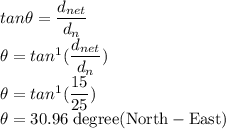
Physics, 06.12.2019 07:31, luisgonz5050
8. an ant on a picnic table travels 30 cm eastward, then 25 cm northward, and finally 15 cm westward. what is the ant's displacement, angle, and direction
relative to its original position?

Answers: 3
Other questions on the subject: Physics

Physics, 21.06.2019 21:30, AleOfficial101
Aparticle with mass 1.81×10−3 kg and a charge of 1.22×10−8 c has, at a given instant, a velocity v⃗ =(3.00×104m/s)j^. what are the magnitude and direction of the particle’s acceleration produced by a uniform magnetic field b⃗ =(1.63t)i^+(0.980t)j^?
Answers: 2

Physics, 21.06.2019 22:00, westes0376
Orque can be calculated by multiplying the force (n) applied at 90? to the lever arm at a distance (m) from the pivot point (point of rotation), the compound si unit for the torque is n? m. if the force (at 90? to the lever arm) applied is 15 n and it is applied at 2.0 m from the pivot point (point of rotation), what is the torque on the lever?
Answers: 3

Physics, 21.06.2019 23:20, ElizabethF
Asmall, positively charged ball is moved close to a large, positively charged ball. which describes how the small ball likely responds when it is released? it will move toward the large ball because like charges repel. it will move toward the large ball because like charges attract. it will move away from the large ball because like charges repel. it will move away from the large ball because like charges attract.
Answers: 3

Physics, 22.06.2019 01:40, sasalinas2001
In all trials, the magnitude of the final velocity for g1 + g2 was less than the magnitude of any initial velocity. as mass increased, what happened to the velocity? the velocity decreased. the velocity increased. the velocity of g1 + g2 could not be measured. the velocity was not affected by the mass increase.
Answers: 1
Do you know the correct answer?
8. an ant on a picnic table travels 30 cm eastward, then 25 cm northward, and finally 15 cm westward...
Questions in other subjects:









Social Studies, 01.08.2019 18:00



 .
. .
.






